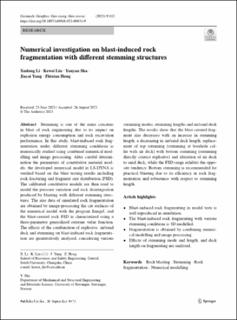| dc.contributor.author | Li, Xudong | |
| dc.contributor.author | Liu, Kewei | |
| dc.contributor.author | Sha, Yanyan | |
| dc.contributor.author | Yang, Jiacai | |
| dc.contributor.author | Hong, Zhixian | |
| dc.date.accessioned | 2023-10-12T11:42:19Z | |
| dc.date.available | 2023-10-12T11:42:19Z | |
| dc.date.created | 2023-09-26T13:29:03Z | |
| dc.date.issued | 2023-09 | |
| dc.identifier.citation | Li, X., Liu, K., Sha, Y., Yang, J. & Hong, Z. (2023) Numerical investigation on blast-induced rock fragmentation with different stemming structures. Geomechanics and Geophysics for Geo-Energy and Geo-Resources, 9, 112 | en_US |
| dc.identifier.issn | 2363-8419 | |
| dc.identifier.uri | https://hdl.handle.net/11250/3096085 | |
| dc.description.abstract | Stemming is one of the main concerns in blast of rock engineering due to its impact on explosion energy consumption and rock excavation performance. In this study, blast-induced rock fragmentation under different stemming conditions is numerically studied using combined numerical modelling and image processing. After careful determination the parameters of constitutive material models, the developed numerical model in LS-DYNA is verified based on the blast testing results including rock fracturing and fragment size distribution (FSD). The calibrated constitutive models are then used to model the pressure variation and rock disintegration produced by blasting with different stemming structures. The size data of simulated rock fragmentation are obtained by image-processing the cut surfaces of the numerical model with the program ImageJ, and the blast-created rock FSD is characterized using a three-parameter generalized extreme value function. The effects of the combination of explosive, air/sand deck and stemming on blast-induced rock fragmentation are quantitatively analysed, considering various stemming modes, stemming lengths and air/sand deck lengths. The results show that the blast-created fragment size decreases with an increase in stemming length, a decreasing in air/sand deck length, replacement of top stemming (stemming at borehole collar with air deck) with bottom stemming (stemming directly contact explosive) and alteration of air deck to sand deck, while the FSD range exhibits the opposite tendency. Bottom stemming is recommended for practical blasting due to its efficiency in rock fragmentation and robustness with respect to stemming length. | en_US |
| dc.language.iso | eng | en_US |
| dc.publisher | Springer Nature Switzerland AG | en_US |
| dc.rights | Navngivelse 4.0 Internasjonal | * |
| dc.rights.uri | http://creativecommons.org/licenses/by/4.0/deed.no | * |
| dc.subject | geologi | en_US |
| dc.title | Numerical investigation on blast-induced rock fragmentation with different stemming structures | en_US |
| dc.type | Peer reviewed | en_US |
| dc.type | Journal article | en_US |
| dc.description.version | publishedVersion | en_US |
| dc.rights.holder | © 2023 The Author(s). | en_US |
| dc.subject.nsi | VDP::Matematikk og Naturvitenskap: 400::Geofag: 450 | en_US |
| dc.source.volume | 9 | en_US |
| dc.source.journal | Geomechanics and Geophysics for Geo-Energy and Geo-Resources | en_US |
| dc.source.issue | 1 | en_US |
| dc.identifier.doi | 10.1007/s40948-023-00654-9 | |
| dc.identifier.cristin | 2179040 | |
| dc.source.articlenumber | 112 (2023) | en_US |
| cristin.ispublished | true | |
| cristin.fulltext | original | |
| cristin.qualitycode | 1 | |

